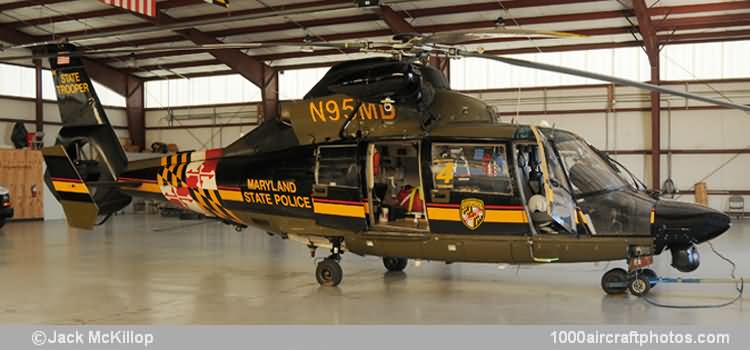On March 19, 1970 their role was expanded into medical evacuation (medevac) and this command became the first civilian agency to transport a critically injured trauma patient by helicopter. Never before had this been done in a non-military setting. Today, the Aviation Command has five separate missions: medevac, aerial law enforcement, search and rescue, homeland security, and disaster assessment.
To accomplish these five missions, the command has a fleet of 11 helicopters, all Dauphins (Dolphins):
2 Aérospatiale SA 365 N1: N57MD c/n 6252, N92MD c/n 6311, N93MD c/n 6316. N92MD crashed on September 28,
2008, with the loss of both crew, a paramedic, and a patient. A second patient survived with severe injuries.
2 Eurocopter AS365 N2: N61MD c/n 6462, N65MD c/n 6464
7 Eurocopter AS365 N3: N38MD c/n 6335, N79MD c/n 6352, N82MD c/n 6550, N94MD c/n 6317, N95MD c/n 6320,
N96MD c/n 6321, N97MD c/n 6330.
Each helicopter is equipped with twin gas turbine engines, full IFR capability, GPS, a state-of-the-art medical interior, FLIR and a NightSun searchlight. These aircraft, all identified as 'Trooper' and showing a stuck-on number on the center cabin door, indicating on which of the following seven locations in Maryland it is based (the 11 aircraft alternate between them).
Trooper 1: Martin State Airport, Middle River
Trooper 2: Andrews AFB, Camp Springs
Trooper 3: Frederick Municipal Airport, Frederick
Trooper 4: Salisbury-Ocean City Wicomico Regional Airport, Salisbury
Trooper 5: Greater Cumberland Regional Airport, Cumberland
Trooper 6: Easton/Newnam Field Airport, Easton
Trooper 7: St. Mary's County Regional Airport, Leonardtown
(Trooper 8, an eighth location at Norwood, Montgomery County, was closed down)
In October 2010, the state of Maryland contracted for six new Agusta AW139 helicopters to replace the oldest of the current helicopters, eight of which currently in use are more than 20 years old. (The aircraft in the photo above was built in 1989 and registered to the Maryland State Police on November 15, 1989.) The first two AW139s are expected to be delivered in about 18 months with all six are expected to be in operation in less than two years."
